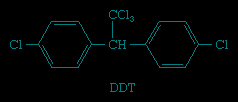DDT
chemical compound
abbreviation of dichlorodiphenyltrichloroethane, also called 1,1,1-trichloro-2,2-bis(p-chlorophenyl)ethane,
 a synthetic insecticide belonging to the family of organic halogen compounds, highly toxic toward a wide variety of insects as a contact poison that apparently exerts its effect by disorganizing the nervous system.
a synthetic insecticide belonging to the family of organic halogen compounds, highly toxic toward a wide variety of insects as a contact poison that apparently exerts its effect by disorganizing the nervous system.DDT, prepared by the reaction of chloral with chlorobenzene in the presence of sulfuric acid, was first made in 1874; its insecticidal properties were discovered in 1939 by a Swiss chemist, Paul Hermann Müller (Müller, Paul Hermann). During and after World War II, DDT was found to be effective against lice, fleas, and mosquitoes (the carriers of typhus, of plague, and of malaria and yellow fever, respectively) as well as the Colorado potato beetle, the gypsy moth, and other insects that attack valuable crops.
Many species of insects rapidly develop populations resistant to DDT; the high stability of the compound leads to its accumulation in insects that constitute the diet of other animals, with toxic effects on them, especially certain birds and fishes. These two disadvantages had severely decreased the value of DDT as an insecticide by the 1960s, and severe restrictions were imposed on its use in the United States in 1972.
Pure DDT is a colourless, crystalline solid that melts at 109° C (228° F); the commercial product, which is usually 65 to 80 percent active compound, along with related substances, is an amorphous powder that has a lower melting point. DDT is applied as a dust or by spraying its aqueous suspension.
- Jerome Robbins
- Jerome, Saint
- Jerome S. Bruner
- Jerrold, Douglas William
- Jerry Bruckheimer
- Jerry Falwell
- Jerry J. Rawlings
- Jerry Lee Lewis
- Jerry Lewis
- Jerry Rice
- Jerry Seinfeld
- Jersey
- Jersey Act
- Jersey City
- Jersey, flag of
- Jersey Joe Walcott
- Jersey Zoological Park
- Jerusalem
- Jerusalem artichoke
- Jerusalem, Assizes of
- Jerusalem, Council of
- Jerusalem cricket
- Jerusalem, kingdom of
- Jerusalem Post, The
- Jerusalem, Synod of